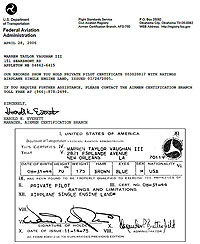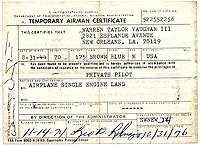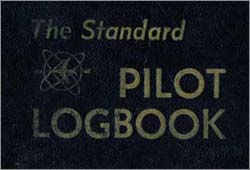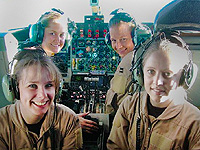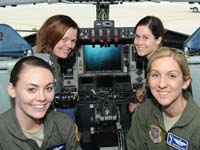|
Vaughan Family Timestream® Maps |
| Home Biography People Places Multimedia: Making It Work On the Water Writings/Presentations |
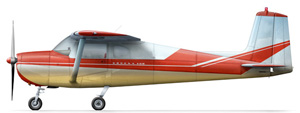
Flying
Testimony
When I was 5, my Uncle David Vaughan took the family up in a Piper Cub to circle Abington, Mass. I will never forget pressing my nose to the plastic and looking down at the Monopoly houses and the cars like ants in the streets.
When I was 16, I wanted very much to go into space, to join those teams of engineers and scientists who were building lunar bases, exploring the caverns of Mars, and draining the swamps of Venus.
When I was 17, I got my first pair of glasses with the normal wonderment of "Jesus, I can see the blackboard," and oncoming traffic at night became sharp-focused instead of a dandelion parade. My eyes weren't bad, but I sort of gave up on being able to join the Air Force and pilot the rockets...
When I was 28, I could navigate anywhere in the world with sextant and compass and was familiar with the two-dimensional space of the ocean surface. I knew about lift and drag, p-factors, torque, and cross-winds. I could communicate clearly on the radio.
Three-Space and Unusual Attitudes:
Learning to fly added a third dimension of altitude management to my skillset. But it scared hell out of me. Stall practice, where you idle the motor and pull back on the stick until you are looking straight up at the sky and the warning buzzer screams in your ear, and the plane lurches into a recovery (only once a spin which whitefaced my instructor), and you jam your hand to the throttle for power, and your altitude is suddenly three hundred feet less and the nose is still down..
These things I found disturbing. More, I had just completed a long ocean cruise with a two-cycle German auxillary engine (weighed 24 pounds) that required cotton swab care and three rebuilds, and which had quit at the delicate entrances of Salina Cruz, Mexico and Balboa, Panama, and Long Island in the Bahamas and West Palm Beach, Florida and Cape May and Atlantic City, New Jersey. And it always quit when I needed it most to enter a channel or mooring area or a tight marina.
Now, I knew that the Lycomings and Continentals that powered these airplanes had TWO spark plugs in each cylinder, TWO magnetos, and had been INSPECTED by certified powerplant mechanics. But my imagination would crank away, exercising the actuarial tables and playing what if games just below the activity levels of consciousness. The rational mind checks the VOR and altimeter, the non-rational mind sees a propeller slicing into peripheral vision and cotter pins vibrating loose as elevators fall off into the clouds below... The Dune Mantra: "Fear is the mindkiller..." reminds me always of this mental double vision, and I struggle to keep poised. Complacency does not exist.
Practicing emergency situations (the CFI shoves in the throttle and says "Engine out, bring us down alive...") should have been helpful. Pick a spot, set up descent and glide. And practice was indeed a confidence-builder until I witnessed the upside down Piper Arrow tangled in the high-voltage lines along the median divider of a New Orleans street: they ran out of fuel on final approach to Lakefront (no altitude, no power, few choices). We heard the radio traffic while in the air, so my instructor and I made the bad decision to drive over and see it once we were on the ground. Not like a Cadillac with steel reinforcing and lots of heavy metal; these planes have a thin foil of an aluminum shell, not good for unusual impact and other such stress. We wandered around in a quiet hush as the sun set. Nobody survived.
DOING IT
To get your pilot's license, a number of things must occur simultaneously:
You need time.
The learning process is like anything mechanical and involving thought (an automobile driver's license), and it takes repetition and familiarization with new concepts and muscle skills. You need to jump head-first onto the learning curve and concentrate on this new experience. You need to fly a few times a week. You need to get used to it.
You need money.
I was lucky. I sold the Great Bear, I had a few dollars, and I found a hungry flight school with planes and Certified Flight Instructors (CFIs) for $18/hour, wet (meaning gas included).
You need to be able to accept the risk.
Private flying is statistically dangerous. When my company purchased a key person life insurance policy for me in the early 80's, the underwriters wanted assurances that I no longer flew private aircraft.
